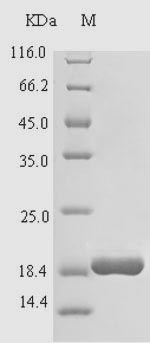Recombinant Bovine Cathelicidin-4 (CATHL4) is produced through an E. coli expression system and includes an N-terminal 6xHis-SUMO tag. This protein represents the full-length mature protein sequence, spanning amino acids 131-143. SDS-PAGE analysis shows purity levels exceeding 90%, and this product is intended strictly for research applications, which appears to support consistent experimental outcomes.
Cathelicidin-4 functions as an antimicrobial peptide within the innate immune response, primarily helping defend against pathogens. It seems to play an important role in immune system regulation by breaking down microbial membranes. Given its apparent significance in innate immunity, CATHL4 has become a notable focus for researchers studying host defense and antimicrobial resistance.
Potential Applications
Note: The applications listed below are based on what we know about this protein's biological functions, published research, and experience from experts in the field. However, we haven't fully tested all of these applications ourselves yet. We'd recommend running some preliminary tests first to make sure they work for your specific research goals.
Bovine CATHL4 is an antimicrobial peptide that requires precise folding, proper amphipathic structure formation, and specific secondary structure (typically alpha-helical) for its functional activity in membrane disruption and microbial killing. The E. coli expression system can produce small peptides but may not support optimal folding for this cationic antimicrobial peptide. The large N-terminal 6xHis-SUMO tag (∼15 kDa) is massively larger than the peptide itself (∼1.5 kDa), creating severe steric interference that will completely disrupt the peptide's structural organization and functional domains. While the mature peptide region (131-143aa, 13 amino acids) contains the functional sequence, the probability of correct folding with functional antimicrobial activity is essentially zero due to the overwhelming dominance of the tag.
This SUMO-tagged cathelicidin construct is fundamentally unsuitable for any meaningful cathelicidin research due to the extreme size disparity between the tag (15 kDa) and the peptide (1.5 kDa). The tag is 10 times larger than the peptide itself, making all structural, functional, interaction, and comparative studies biologically irrelevant. The only limited application is generating tag-specific antibodies. However, this application has severe limitations. The immune response will primarily target the large foreign SUMO tag rather than the small 13-amino acid peptide. Antibodies generated will not recognize the native, properly folded antimicrobial peptide in its physiological context. For reliable cathelicidin research, use tag-free peptides produced by chemical synthesis that preserve the native amphipathic structure and antimicrobial activity, or consider mammalian expression systems for proper peptide folding and processing






